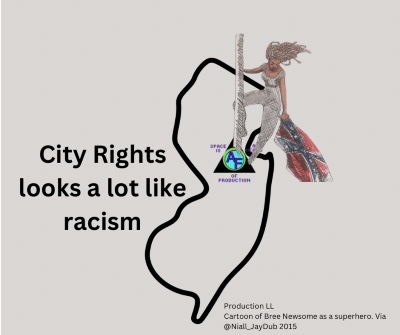Rising Tides, Uneven Shores: The Political Economy of Climate Resilience

Hoboken's celebrated "Resist, Delay, Store, Discharge" strategy appears in planning literature as a triumph of urban adaptation—a case study in climate resilience ready for export to coastal cities worldwide. The narrative of transformation following Hurricane Sandy's devastation focuses on technical innovation and municipal foresight. Yet beneath this technocratic framing lies a more revealing story about which spaces merit protection and which communities bear the burden of climate vulnerability.
The strategy itself—with its carefully engineered flood barriers, water retention basins, and pumping systems—represents a significant achievement in urban climate infrastructure. Its components form an impressive defense network designed to control water's movement through urban space. But the geography of implementation reveals priorities that extend beyond mere technical considerations. The protected zones align with remarkable precision to property values and demographic patterns that predate climate awareness.
In Hoboken, resilience infrastructure manifests most visibly in areas where real estate commands premium prices. The waterfront, once industrial, now hosts luxury condominiums whose glass facades reflect both the Hudson River and the substantial investment in protective measures surrounding them. The physical infrastructure of resilience—aesthetically integrated into parks and public spaces—serves simultaneously as amenity and defense system for those who can afford proximity.
Meanwhile, in Newark's Portside neighborhood, just miles away but separated by municipal boundaries and socioeconomic gulfs, resilience takes a different form. Here, adaptation remains largely the responsibility of individual households and community organizations operating with minimal resources. The absence of comprehensive infrastructure reflects not technical impossibility but political economy—the calculus of which populations merit public investment in their continued habitation of vulnerable spaces.
This pattern repeats along New Jersey's coastline with predictable consistency. Atlantic City presents perhaps the most striking manifestation of disparate vulnerability. The casino district rises on engineered elevations and benefits from beach replenishment programs funded through multiple government agencies. Just blocks away, predominantly Black and Latine neighborhoods experience routine flooding with minimal infrastructural relief. The water respects neither municipal boundaries nor property lines, yet the response to its intrusion varies dramatically across socioeconomic gradients.
The technical documents detailing these resilience strategies employ the neutral language of engineering and hydrology. They speak of catchment areas, permeable surfaces, and flow rates—a vocabulary that obscures the fundamentally political nature of adaptation planning. The passive construction of these documents—areas "prioritized for protection," neighborhoods "identified as vulnerable"—masks the active decisions determining which spaces and populations will weather the coming storms.
Climate resilience planning requires choices—decisions about resource allocation, protection priorities, and acceptable loss. In theory, these decisions might stem from purely technical considerations: topography, population density, critical infrastructure. In practice, they reflect and reinforce existing patterns of advantage and marginalization. The maps of projected sea-level rise and the maps of poverty in coastal New Jersey share disturbing similarities, not because climate change discriminates but because our responses to it do.
The vocabulary of resilience itself merits scrutiny. The term has migrated from ecology to urban planning with subtle but significant alterations. In ecological systems, resilience describes the capacity to maintain essential functions through disturbance—not necessarily returning to an identical state but preserving core characteristics. In urban planning discourse, resilience often becomes synonymous with preservation of existing development patterns and property relations, regardless of their sustainability or equity implications.
What would genuine climate resilience look like in New Jersey's coastal communities? It would require recognition that vulnerability stems not merely from proximity to rising waters but from historical patterns of disinvestment and segregation. It would acknowledge that the most technically sophisticated infrastructure solutions cannot resolve the underlying disparities that determine who can retreat from climate threats and who must face them with inadequate resources.
In Hoboken, genuine resilience might mean extending the benefits of the "Resist, Delay, Store, Discharge" strategy beyond municipal boundaries to neighboring communities with fewer resources. In Atlantic City, it might require questioning whether continued investment in protecting luxury gambling venues represents the most equitable use of limited adaptation funds. Throughout the region, it would necessitate treating resilience not as a technical challenge but as an opportunity to address long-standing environmental justice concerns.

The Dutch water management experts frequently consulted by New Jersey municipalities bring valuable technical expertise. What they cannot provide is guidance on the ethical dimensions of climate adaptation. These consultants can design systems to manage water; they cannot determine which communities deserve protection. That determination reflects political priorities and social values that predate climate awareness.
As waters rise along New Jersey's coast, the geography of protection emerges with increasing clarity. The infrastructure of resilience—visible in flood barriers, pumping stations, elevated structures—forms a map of value more accurate than any real estate assessment. Climate adaptation planning, presented as technical and apolitical, reveals itself as profoundly shaped by existing hierarchies of race, class, and political influence.
The residents of Portside in Newark understand this reality without benefit of technical reports or vulnerability assessments. They experience it with each rainfall that overwhelms aging drainage systems, each storm surge that enters ground-floor apartments, each denial of insurance coverage for repeatedly flooded properties. Their resilience—improvised, community-based, operating with minimal resources—remains largely invisible in official planning documents but proves essential to their continued habitation of vulnerable spaces.
The coming decades will reveal whether New Jersey's coastal cities can develop adaptation strategies that break from historical patterns of uneven development. The technical solutions exist. The capacity to implement them equitably remains in question. As the tide rises against all shores, the distribution of dry ground will reveal our true priorities more clearly than any planning document or public pronouncement.






